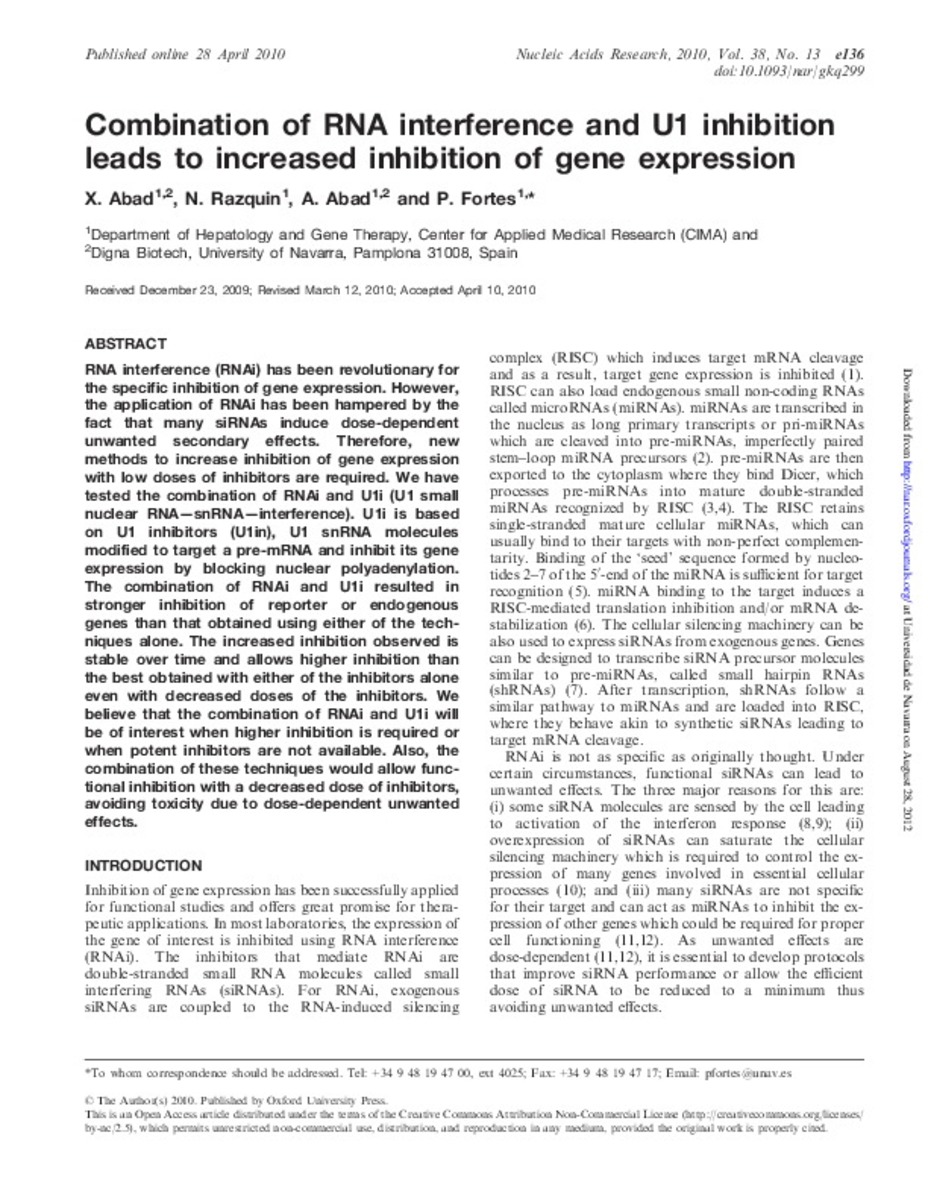Full metadata record
| DC Field | Value | Language |
|---|---|---|
| dc.creator | Abad, X. (Xabier) | - |
| dc.creator | Razquin, N. (Nerea) | - |
| dc.creator | Abad, A. (Amaya) | - |
| dc.creator | Fortes, P. (Puri) | - |
| dc.date.accessioned | 2012-09-24T12:22:35Z | - |
| dc.date.available | 2012-09-24T12:22:35Z | - |
| dc.date.issued | 2010 | - |
| dc.identifier.citation | Abad X, Razquin N, Abad A, Fortes P. Combination of RNA interference and U1 inhibition leads to increased inhibition of gene expression. Nucleic Acids Res 2010 Jul;38(13):e136. | es_ES |
| dc.identifier.issn | 1362-4962 | - |
| dc.identifier.uri | https://hdl.handle.net/10171/23170 | - |
| dc.description.abstract | RNA interference (RNAi) has been revolutionary for the specific inhibition of gene expression. However, the application of RNAi has been hampered by the fact that many siRNAs induce dose-dependent unwanted secondary effects. Therefore, new methods to increase inhibition of gene expression with low doses of inhibitors are required. We have tested the combination of RNAi and U1i (U1 small nuclear RNA--snRNA--interference). U1i is based on U1 inhibitors (U1in), U1 snRNA molecules modified to target a pre-mRNA and inhibit its gene expression by blocking nuclear polyadenylation. The combination of RNAi and U1i resulted in stronger inhibition of reporter or endogenous genes than that obtained using either of the techniques alone. The increased inhibition observed is stable over time and allows higher inhibition than the best obtained with either of the inhibitors alone even with decreased doses of the inhibitors. We believe that the combination of RNAi and U1i will be of interest when higher inhibition is required or when potent inhibitors are not available. Also, the combination of these techniques would allow functional inhibition with a decreased dose of inhibitors, avoiding toxicity due to dose-dependent unwanted effects. | es_ES |
| dc.language.iso | eng | es_ES |
| dc.publisher | Oxford University Press | es_ES |
| dc.rights | info:eu-repo/semantics/openAccess | es_ES |
| dc.subject | RNA Interference | es_ES |
| dc.subject | RNA, Small Nuclear/antagonists & inhibitors | es_ES |
| dc.title | Combination of RNA interference and U1 inhibition leads to increased inhibition of gene expression | es_ES |
| dc.type | info:eu-repo/semantics/article | es_ES |
| dc.relation.publisherversion | http://nar.oxfordjournals.org/content/38/13/e136 | es_ES |
| dc.type.driver | info:eu-repo/semantics/article | es_ES |
Files in This Item:
Statistics and impact
Items in Dadun are protected by copyright, with all rights reserved, unless otherwise indicated.






